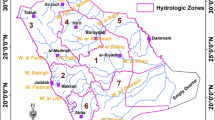Abstract
Water resources all over the world are facing several problems such as scarcity, pollution, climate change, and global warming. Arid zones especially suffer from either severe drought or severe floods. Scientific analysis of flood events is difficult because of lacking flood measurement data and rainfall-runoff models that are suited for arid regions. Researchers in the field of hydrology are developing rainfall-runoff models for storm runoff predictions since 1932. However, it is noticeable that most research papers, books, and theses are considering studies in temperate regions, while arid zones are lacking such studies. The main objective of this paper is to derive a mathematical model called Ari-Zo, using regression analysis, to predict flood peaks, time to peak, and time of concentration from rainfall storms in arid zones. The data used in this study relied on storm measurements registered at Allith and Yiba basins and their subcatchments (eight subbasins) located in the southwestern part of Saudi Arabia. The stream flow data method has been used to derive the unit hydrograph in the Ari-Zo model from 36 storms. The study developed several mathematical relationships between the hydrological variables and the regional topography of the basins. The mathematical equations obtained from this study are the discharge peaking factor, time of concentration, and time to peak. The Ari-Zo model results are compared with the results of the National Resources Conservation Service (NRCS) method and showed substantial differences. The peaking factors of NRCS range between 0.0646 and 0.2582, while in Ari-Zo, it ranges between 0.0513 (low flood case) and 1.9465 (very extreme flood case). The ratio between the time to peak and the time of concentration in NRCS is equal to 0.667, while in Ari-Zo, it ranges between 0.05 and 0.5 and on average, it is 0.276. The parameters of time of concentration in Ari-Zo model are different from those of Kirpich equation. The study recommends using the Ari-Zo model for arid zone hydrological studies.
















Similar content being viewed by others
References
Abu-Alainine HA (1979) Geomorphology, Beirut, Dar Al-Nahdah Al-Arabia, 5th Edition. In Arabic
Albishi M (2015) Unit hydrograph of watersheds in arid zones: case study in south western Saudi Arabia, MSc Thesis, King Abdulaziz University, Saudi Arabia
Alriyadh Newspaper (2011) vol. 15559 in 29/01/2011. Available at http://www.alriyadh.com/599456. Accessed May 17, 2015
Al-Sharif AS (1977) Geography of Saudi Arabia, Riyadh, Dar Al-Marrekh Press, vol.1, In Arabic
Al-watan online news (2010) in 10/05/2010. Available at http://www.alwatan.com.sa/Local/News_Detail.aspx?ArticleID=1623&CategoryID=5. Accessed Nov 8, 2015
Bajabaa S, Masoud MH, Al-Amri N (2014) Flash flood hazard mapping based on quantitative hydrology, geomorphology and GIS techniques (case study of Wadi Al Lith, Saudi Arabia). Arab J Geosci 7:2469–2481
Bhunya PK, Mishra SK, Berndtsson R (2003) Simplified two-parameter gamma distribution for derivation of synthetic unit hydrograph. Journal of Hydrology Engineering 8:226–230
Cater FW, Johnson PR (1987) Geologic map of the Jabal Ibrahim quadrangle, Sheet 20E, Kingdom of Saudi Arabia: Saudi Arabian Deputy Ministry for Mineral Resources Geologic Map GM 96, scale 1:250,000
Clark CO (1945) Storage and the unit hydrograph. Transactions of American Society of Civil Engineers 110:1419–1446
Edson CG (1951) Parameters for relating unit hydrograph to watershed characteristics. Trans Am Geophys Union 32(4):591–596
Fang X, Prakash K, Cleveland T, Thompson D, Pradhan P (2005) Revisit of NRCS Unit Hydrograph Procedures, (Proceedings of the ASCE Texas Section Spring Meeting) Austin, Texas. Available at: http://cleveland2.ce.ttu.edu/documents/copyright/ and http://www.eng.auburn.edu/~xzf0001/Publications.htm. Accessed April 21, 2015
Gray DM (1961) Synthetic Unit Hydrographs for Small Drainage Areas, Proceeding American Society of Civil Engineers, vol. 87
Greenwood WR, Jackson RO, Johnson PR (1986) Geologic map of the Jabal Al-Hasir quadrangle, Sheet 19F, Kingdom of Saudi Arabia: Saudi Arabian Deputy Ministry for Mineral Resources Geologic Map GM 94, scale 1:250,000
Hunt B (1985) The meaning of oscillations in unit hydrograph S-curves. Hydrol Sci J 30:331–342
Kirpich ZP (1940) Time of concentration of small agricultural watersheds, Civil Engineering Journal. vol. 10, No. 6
McCuen RH, Johnson PA, Ragan RM (2002) Highway hydrology, 2nd edn. U.S. Department of Transportation, Washington, D.C.
Mockus V (1957) Use of storm and watershed characteristics in synthetic hydrograph analysis and application, Washington D.C.: U.S. Department of Agriculture, Soil Conservation Services
Natural Resources Conservation Services (1972) National Engineering Handbook, Section 4: Hydrology, Washington D.C.: U.S. Department of Agriculture
Okaz Newspaper (2014) vol. 4709 in 09/05/2014. Available at: http://www.okaz.com.sa/new/Issues/20140509/Con20140509698234.htm. Accessed May 4, 2015
Pallister JS (1986) Geologic map of the Al-Lith quadrangle, Sheet 20D, Kingdom of Saudi Arabia: Saudi Arabian Deputy Ministry for Mineral Resources Geoscience Map GM 95C, scale 1:250,000
Prinz WC (1983) Geologic map of the Al Qunfudhah quadrangle, Sheet 19E, Kingdom of Saudi Arabia: Saudi Arabian Deputy Ministry for Mineral Resources Geologic Map GM 70, scale 1:250,000
Prinz WC (1984) Geologic map of the Wadi Haliy quadrangle, Sheet 18E, Kingdom of Saudi Arabia: Saudi Arabian Deputy Ministry for Mineral Resources Geologic Map GM 74, scale 1:250,000
Raghunath HM (2006) Hydrology. New Age International, New Delhi
Sherman LK (1932) Stream-flow from rainfall by the unit-graph method. Engineering News-Record 105:501–505
Singh PK, Jain MK, Mishra SK (2011) Fitting a simplified two-parameter gamma distribution function for synthetic sediment graph derivation from ungauged catchments. Arab Journal of Geosciences 6:1835–1841
Snyder FF (1938) Synthetic unit graphs. Transactions American Geophysical Union 19:447–454
Viessman JW, Lewis GR (2002) Introduction to hydrology, 5th edn. Prentice Hall, Bergen
Viessman JW, Knapp JW, Lewis GR, Harbaugh TE (1977) Introduction to hydrology, 2nd edn. Harper & Row, New York
Author information
Authors and Affiliations
Corresponding author
Rights and permissions
About this article
Cite this article
Albishi, M., Bahrawi, J. & Elfeki, A. Empirical equations for flood analysis in arid zones: the Ari-Zo model. Arab J Geosci 10, 51 (2017). https://doi.org/10.1007/s12517-017-2832-4
Received:
Accepted:
Published:
DOI: https://doi.org/10.1007/s12517-017-2832-4




